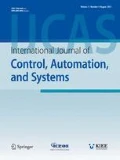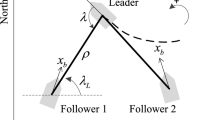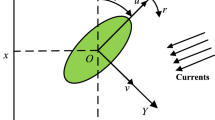Abstract
This paper presents a new cooperative control strategy for dynamic positioning of multiple surface vessels subject to unknown time-varying environmental disturbances and input saturation. The vessels are assumed interconnected through a directed topology rather than bidirectional. Two control objectives are considered in this paper. The first one is to make these vessels track desired positions and headings, and the other control objective is to hold the desired formation. For these purposes, we propose a cooperative control which consists of finite-time disturbance observer, auxiliary dynamic system and dynamic surface control technique. A nonlinear finite-time observer is developed to estimate unknown time-varying disturbance. To tackle the input saturation problem, an auxiliary dynamic system is constructed. It is also proved that all signals in the closed-loop control system converge to a small neighborhood of equilibrium state via Lyapunov analysis. Simulation results are given to validate the effectiveness of the proposed control strategy.
Similar content being viewed by others
References
A. J. Sørensen, “A survey of dynamic positioning control systems,” Annual Reviews in Control, vol. 35, no. 1, pp. 123–136, 2011.
J. G. Balchen, N. A. Jenssen, E. Mathisen, and S. Saelid, “Dynamic positioning system based on Kalman filtering and optimal control,” Modeling, Identification and Control, vol. 1, no. 3, pp. 135–163, 1980.
T. I Fossen and Å. Grøvlen, “Nonlinear output feedback control of dynamically positioned ships using vectorial observer backstepping,” IEEE Transactions on Control Systems Technology,vol. 6, no. 1, pp. 121–128, 1998.
E. Tannuri, A. Agostinho, H. Morishita, and L. Moratelli, “Dynamic positioning systems: an experimental analysis of sliding mode control,” Control Engineering Practice, vol. 18, no. 6, pp. 1121–1232, 2010.
T. D. Nguyen, A. J. Sørensen, and S. Tong Quek, “Design of hybrid controller for dynamic positioning from calm to extreme sea conditions,” Automatica, vol. 43, no. 5, pp. 768–785, 2007.
L. Liu, D. Wang, and Z. Peng, “Direct and composite iterative neural control for cooperative dynamic positioning of marine surface vessels,” Nonlinear Dynamics, vol. 81, no. 3, pp. 1–14, 2015.
Z. Peng, D. Wang, and J. Wang, “Cooperative dynamic positioning of multiple marine offshore vessels: A modular design,” IEEE/ASME Transactions on Mechatronics, vol. 21, no. 3, pp. 1210–1221, 2016.
G. Xia, J. Xue, and J. Jiao, “Dynamic positioning control system with input time–delay using fuzzy approximation approach,” International Journal of Fuzzy Systems, vol. 20, no. 2, pp. 630–639, 2018.
G. Xia, C. Pang, and J. Xue, “Fuzzy neural network–based robust adaptive control for dynamic positioning of underwater vehicles with input dead–zone,” Journal of Intelligent and Fuzzy System, vol. 29, no. 6, pp. 2585–2595, 2015.
G. Xia, H. Wu, and X. Shao, “Adaptive filtering backstepping for ships steering control without velocity measurements and with input constraints,” Mathematical Problems in Engineering, vol. 2014, no. 3, pp. 1–9, 2014.
G. Xia, X. Shao, and A. Zhao, “Robust nonlinear observer and observer–backstepping control design for surface ships,” Asian Journal of Control, vol. 17, no. 4, pp. 1377–1393, 2015.
J. Wang, S. He, and D. Lin, “Robust backstepping control for a class of nonlinear systems using generalized disturbance observer,” International Journal of Control, Automation and Systems, vol. 14, no. 6, pp. 1475–1483, 2016.
K. D. Do, “Practical control of underactuated ships,” Ocean Engineering, vol. 37, no. 13, pp. 1111–1119, 2010.
Y. Li and J. Zheng, “The design of ship formation based on a novel disturbance rejection control,” International Journal of Control, Automation and Systems, vol. 16, no. 4, pp. 1833–1839, 2018.
C. Wen, J. Zhou, Z. Liu, and H. Su, “Robust adaptive control of uncertain nonlinear systems in the presence of input saturation and external disturbance,” IEEE Transactions on Automatic Control, vol. 56, no. 7, pp. 1672–1678, 2011.
M. Chen, S. S. Ge, and B. Ren, “Adaptive tracking control of uncertain MIMO nonlinear systems with input constraints,” Automatica, vol. 47, no. 3, pp. 452–465, 2011.
D. D. Wang, G. F. Wang, and Y. S. Fan, “Guidance laws against towed decoy based on adaptive back–stepping sliding mode and anti–saturation methods,” International Journal of Control, Automation and Systems, vol. 16, no. 4, pp. 1724–1735, 2018.
J. Du, X. Hu, M. Krstić, and Y. Sun, “Robust dynamic positioning of ships with disturbances under input saturation,” Automatica, vol. 73, pp. 207–214, 2016.
M. Chen, S. S. Ge, B. V. E. How, and Y. S. Choo, “Robust adaptive position mooring control for marine vessels,” IEEE Transactions on Control Systems Technology, vol. 21, no. 2, pp. 395–409, 2013.
S. P. Bhat and D. S. Bernstein, “Finite time stability of continuous autonomous system,” SIAM Journal on Control and Optimization, vol. 38, no. 3, pp. 751–766, 2000.
T. I. Fossen and J. P. Strand, “Passive nonlinear observer design for ships using Lyapunov methods: full–scale experiments with a supply vessel,” Automatica, vol. 35, no. 1, pp. 3–16, 1999.
M. R. Mokhtari, B. Cherki, and A. C. Braham, “Disturbance observer based hierarchical control of coaxial–rotor UAV,” ISA Transactions, vol. 67, pp. 466–475, 2017.
R. Skjetne, T. I. Fossen and P. V. Kokotović, “Adaptive maneuvering, with experiments, for a model ship in a marine control laboratory,” Automatica, vol. 41, no. 2, pp. 289–298, 2005.
T. I. Fossen, “How to incorporate wind, waves and ocean currents in the marine craft equations of motion,” Proc. of 9th IFAC Conf. on Manoeuvring and Control of Marine Craft, pp. 126–131, 2012.
Author information
Authors and Affiliations
Corresponding author
Additional information
Recommended by Associate Editor Andrea Cristofaro under the direction of Editor Myo Taeg Lim. This work was supported by the Funded by the 7th Generation Ultra Deep Water Drilling unit Innovation Project.
Guoqing Xia received the Ph.D. degree in control theory and control engineering from Harbin Engineering University (HEU) in 2001. He is currently working as a professor in HEU. His research interests include ship dynamic positioning control technique, intelligent control theory and system simulation technique.
Chuang Sun received his Bachelor degree in automation from Anyang Institute of Technology in 2015. He is currently working toward to a Ph.D. degree in control science and engineering from Harbin Engineering University. His research interests include ship dynamic positioning control, cooperative control and nonlinear control theory.
Bo Zhao received his Bachelor degree in Automation from Beijing University of Aeronautics and Astronautics (BUAA) in 2006 and his Master degree in Navigation, Guidance and Control from BUAA in 2009. He was awarded Ph.D. degree in Marine Cybernetics from Norwegian University of Science and Technology in 2015. From 2013 to 2018, he served Global Maritime AS as a Senior Marine System Advisor, and developed hardware-in-the-loop testing for dynamic positioning systems. He now works as an Associate Professor in Harbin Engineering University. His research interests are applying advanced control and artificial intelligence in the control of vessel, underwater robotics and other marine systems.
Jingjing Xue is currently working toward to a Ph.D. degree in control science and engineering from Harbin Engineering University. Her research interests include ship dynamic positioning control technique, intelligent control theory and system simulation technique.
Rights and permissions
About this article
Cite this article
Xia, G., Sun, C., Zhao, B. et al. Cooperative Control of Multiple Dynamic Positioning Vessels with Input Saturation Based on Finite-time Disturbance Observer. Int. J. Control Autom. Syst. 17, 370–379 (2019). https://doi.org/10.1007/s12555-018-0383-4
Received:
Revised:
Accepted:
Published:
Issue Date:
DOI: https://doi.org/10.1007/s12555-018-0383-4




